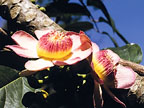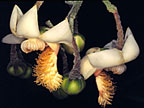

 |
 |
Report corrections to Scott A. Mori (smori@nybg.org)
This is the protologue of Bertholletia excelsa Bonpl. and it is clear from the text that Bonpland is the only author of the species. Bonpland says "Le plant que je viens de décrire est originaire du Brésil. M. Humboldt et moi nous sommes assurés qu'elle se trovoit dans l'Amerique espagnole, formant des forêt sur les bords de l'Orenoque" (The plant that I am describing is native to Brazil. Mr. Humboldt and I are sure that it is found in Spanish America forming forests on the banks of the Orinoco River.").
The protologue is based only on leaves and fruits. Humboldt and Bonpland were unable to obtain flowers even though they offered an ounce of gold for them.
The genus is dedicated to Claude Louis Berthollet, a chemist who, along with Antoine Lavoisier, developed a system of modern chemical nomenclature. Bonpland states the following about Berthollet: "Je le dédie à l'illustre M. Berthollet, à l'on doit tant de découverts, et dont les travaux actuels promettent beacoup à la physiologie et à la chemie des végétaux."
Bonpland and Humbodt were very happy to find Brazil nuts on their trip to the Orinoco. They had lived for three months on bad chocolate and rice cooked with water, always without butter, and often without salt before they procured a great quantity of the fresh fruits of Bertholletia excelsa. As one can imagine, fresh Brazil nut seeds were a welcome addition to their diet.
In the protologue, Bonpland communicates that "A French corsair captured, several months ago, an English ship loaded with Brazil nut fruits.The ship entered the harbor of Rouen, where a businessman, the name of whom is unknown to me, purchased the cargo and made oil that burns well and is better than the oils of Europaean fruits."
I am grateful to the LuEsther T. Mertz Library of The New York Botanical Garden for giving me permission to duplicate this information and to Sandra McNeill for executing the scans and my wife, Carol Gracie, for editing the scans. I thank the Botanical Research Institute of Texas (BRIT) for the financial support that enabled me to make this information about Lecythidaceae available online. Support from BRIT comes from the Andes to Amazon Botany Program (AABP) which, in turn, is supported by a grant from the Gordon Moore Foundation. I am thankful to John Janovec (Director of the AABP) and Sy Sohmer (Director of BRIT) for their committment to taxonomic botany and their willingness to provide funds to advance knowledge of tropical botany. John Janovec has been the driving force behind my desire to make information about Lecythidaceae available online, and I am grateful to him for inspiration and support. Finally, I thank The New York Botanical Garden for making my studies of Lecythidaceae possible.